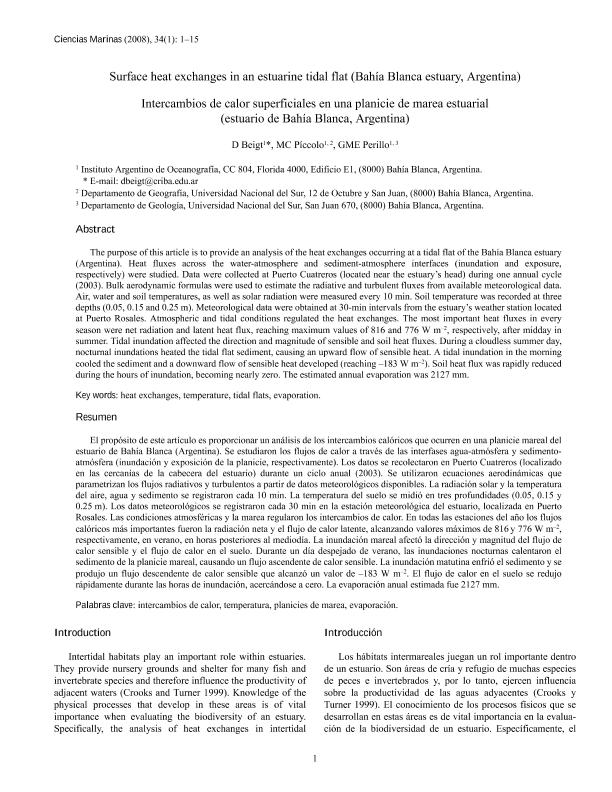Mostrar el registro sencillo del ítem
dc.contributor.author
Beigt, Debora

dc.contributor.author
Piccolo, Maria Cintia

dc.contributor.author
Perillo, Gerardo Miguel E.

dc.date.available
2017-11-21T17:36:56Z
dc.date.issued
2008-12
dc.identifier.citation
Beigt, Debora; Piccolo, Maria Cintia; Perillo, Gerardo Miguel E.; Surface heat exchanges in an estuarine tidal flat (Bahía Blanca estuary, Argentina); Universidad Autónoma de Baja California. Instituto de Investigaciones Oceanológicas; Ciencias Marinas; 34; 1; 12-2008; 1-15
dc.identifier.issn
0185-3880
dc.identifier.uri
http://hdl.handle.net/11336/28630
dc.description.abstract
The purpose of this article is to provide an analysis of the he at exchanges occurring at a tidal flat of the Bahía Blanca estua ry (Argentina). Heat fluxes across the water-atmosphere and sediment-atmosphere interfaces (inundation and exposure, respectively) were studied. Data were collected at Puerto Cuatreros (located near the estuary’s head) during one annual cycle (2003). Bulk aerodynamic formulas were used to estimate the radi ative and turbulent fluxes from available meteorological data. Air, water and soil temperatures, as well as solar radiation were measured every 10 min. Soil temperature was recorded at three depths (0.05, 0.15 and 0.25 m). Meteorological data were obtaine d at 30-min intervals from the estuary’s weather station locate d at Puerto Rosales. Atmospheric and tidal conditions regulated the heat exchanges. The most important heat fluxes in every season were net radiation and latent heat flux, reaching maximum values of 816 and 776 W m –2 , respectively, after midday in summer. Tidal inundation affected the direction and magnitude of sensible and soil heat fluxes. During a cloudless summer day, nocturnal inundations heated the tidal flat sediment, causing an upward flow of sensible heat. A tidal inundation in the mornin g cooled the sediment and a downward flow of sensible heat developed (reaching –183 W m –2 ). Soil heat flux was rapidly reduced during the hours of inundation, becoming nearly zero. The estimated annual evaporation was 2127 mm.
dc.description.abstract
El propósito de este artículo es proporcionar un análisis de los intercambios calóricos que ocurren en una planicie mareal del estuario de Bahía Blanca (Argentina). Se estudiaron los flujos de calor a través de las interfases agua-atmósfera y sedimento- atmósfera (inundación y exposición de la planicie, respectivamente). Los datos se recolectaron en Puerto Cuatreros (localizado en las cercanías de la cabecera del estuario) durante un ciclo anual (2003). Se utilizaron ecuaciones aerodinámicas que parametrizan los flujos radiativos y turbulentos a partir de datos meteorológicos disponibles. La radiación solar y la temperat ura del aire, agua y sedimento se registraron cada 10 min. La temp eratura del suelo se midió en tres profundidades (0.05, 0.15 y 0.25 m). Los datos meteorológicos se registraron cada 30 min en la estación meteorológica del estuario, localizada en Puerto Rosales. Las condiciones atmosféricas y la marea regularon los inte rcambios de calor. En todas las estaciones del año los flujo s calóricos más importantes fueron la radiación neta y el flujo de calor latente, alcanzando valores máximos de 816 y 776 W m –2 , respectivamente, en verano, en horas posteriores al mediodía. La inundación mareal afectó la dirección y magnitud del flujo de calor sensible y el flujo de calor en el suelo. Durante un día despejado de verano, las inundaciones nocturnas calentaron el sedimento de la planicie mareal, causando un flujo ascendente de calor sensible. La inundación matutina enfrió el sedimento y s e produjo un flujo descendente de calor sensible que alcanzó un valor de –183 W m –2 . El flujo de calor en el suelo se redujo rápidamente durante las horas de inundación, acercándose a cero. La evaporación anual estimada fue 2127 mm.
dc.format
application/pdf
dc.language.iso
eng
dc.publisher
Universidad Autónoma de Baja California. Instituto de Investigaciones Oceanológicas

dc.rights
info:eu-repo/semantics/openAccess
dc.rights.uri
https://creativecommons.org/licenses/by-nc-sa/2.5/ar/
dc.subject.classification
Meteorología y Ciencias Atmosféricas

dc.subject.classification
Ciencias de la Tierra y relacionadas con el Medio Ambiente

dc.subject.classification
CIENCIAS NATURALES Y EXACTAS

dc.title
Surface heat exchanges in an estuarine tidal flat (Bahía Blanca estuary, Argentina)
dc.title
Intercambios de calor superficiales en una planicie de marea estuarial (estuario de Bahía Blanca, Argentina)
dc.type
info:eu-repo/semantics/article
dc.type
info:ar-repo/semantics/artículo
dc.type
info:eu-repo/semantics/publishedVersion
dc.date.updated
2017-11-16T14:40:40Z
dc.journal.volume
34
dc.journal.number
1
dc.journal.pagination
1-15
dc.journal.pais
México

dc.journal.ciudad
Mexico
dc.description.fil
Fil: Beigt, Debora. Consejo Nacional de Investigaciones Científicas y Técnicas. Centro Científico Tecnológico Conicet - Bahía Blanca. Instituto Argentino de Oceanografía. Universidad Nacional del Sur. Instituto Argentino de Oceanografía; Argentina
dc.description.fil
Fil: Piccolo, Maria Cintia. Consejo Nacional de Investigaciones Científicas y Técnicas. Centro Científico Tecnológico Conicet - Bahía Blanca. Instituto Argentino de Oceanografía. Universidad Nacional del Sur. Instituto Argentino de Oceanografía; Argentina
dc.description.fil
Fil: Perillo, Gerardo Miguel E..
dc.journal.title
Ciencias Marinas

dc.relation.alternativeid
info:eu-repo/semantics/altIdentifier/url/http://rcmarinas.ens.uabc.mx/index.php/cmarinas/article/view/1194/0
dc.relation.alternativeid
info:eu-repo/semantics/altIdentifier/url/http://ref.scielo.org/ksd35g
Archivos asociados
